
The Climate Change Pact agreed by leaders at the end of COP26 in Glasgow went further than many pessimists had forecast, but not far enough to meet the goal of keeping global warming to 1.5°C above pre-industrial levels. The Pact states that:
limiting global warming to 1.5°C requires rapid, deep and sustained reductions in global greenhouse gas emissions, including reducing global carbon dioxide emissions by 45 per cent by 2030 relative to the 2010 level and to net zero around mid-century, as well as deep reductions in other greenhouse gases.
So how far would the commitments made in Glasgow restrict global warming and what actions need to be put in place to meet these commitments?
Short-term commitments and long-term goals
According to Climate Action Tracker, the short-term commitments to action that countries set out would cause global warming of 2.4°C by the end of the century, the effects of which would be calamitous in terms of rising sea levels and extreme weather.
However, long-term commitments to goals, as opposed to specific actions, if turned into specific actions to meet the goals would restrict warming to around 1.8°C by the end of the century. These long-term goals include reaching net zero emissions by certain dates. For the majority of the 136 countries agreeing to reach net zero, the date they set was 2050, but for some developing countries, it was later. China, Brazil, Indonesia, Russia, Nigeria, Sri Lanka and Saudi Arabia, for example, set a date of 2060 and India of 2070. Some countries set an earlier target and others, such as Benin, Bhutan, Cambodia, Guyana, Liberia and Madagascar, claimed they had already reached zero net emissions.
Despite these target dates, Climate Action Tracker argues that only 6 per cent of countries pledging net zero have robust policies in place to meet the targets. The problem is that actions are required by firms and individuals. They must cut their direct emissions and reduce the consumption of products whose production involved emissions.
 Governments can incentivise individuals and firms through emissions and product taxes, through carbon pricing, through cap-and-trade schemes, through subsidies on green investment, production and consumption, through legal limits on emissions, through trying to change behaviour by education campaigns, and so on. In each case, the extent to which individuals and firms will respond is hard to predict. People may want to reduce global warming and yet be reluctant to change their own behaviour, seeing themselves as too insignificant to make any difference and blaming big business, governments or rich individuals. It is important, therefore, for governments to get incentive mechanisms right to achieve the stated targets.
Governments can incentivise individuals and firms through emissions and product taxes, through carbon pricing, through cap-and-trade schemes, through subsidies on green investment, production and consumption, through legal limits on emissions, through trying to change behaviour by education campaigns, and so on. In each case, the extent to which individuals and firms will respond is hard to predict. People may want to reduce global warming and yet be reluctant to change their own behaviour, seeing themselves as too insignificant to make any difference and blaming big business, governments or rich individuals. It is important, therefore, for governments to get incentive mechanisms right to achieve the stated targets.
Let us turn to some specific targets specified in the Climate Change Pact.
Phasing out fossil fuel subsidies
Paragraph 20 of the Climate Change Pact
Calls upon Parties to accelerate … efforts towards the … phase-out of inefficient fossil fuel subsidies, while providing targeted support to the poorest and most vulnerable in line with national circumstances and recognizing the need for support towards a just transition.
Production subsidies include tax breaks or direct payments that reduce the cost of producing coal, oil or gas. Consumption subsidies cut fuel prices for the end user, such as by fixing the price at the petrol pump below the market rate. They are often justified as a way of making energy cheaper for poorer people. In fact, they provide a bigger benefit to wealthier people, who are larger users of energy. A more efficient way of helping the poor would be through benefits or general tax relief. Removing consumption subsidies in 32 countries alone would, according to International Institute for Sustainable Development, cut greenhouse gas emission by an average of 6 per cent by 2025.
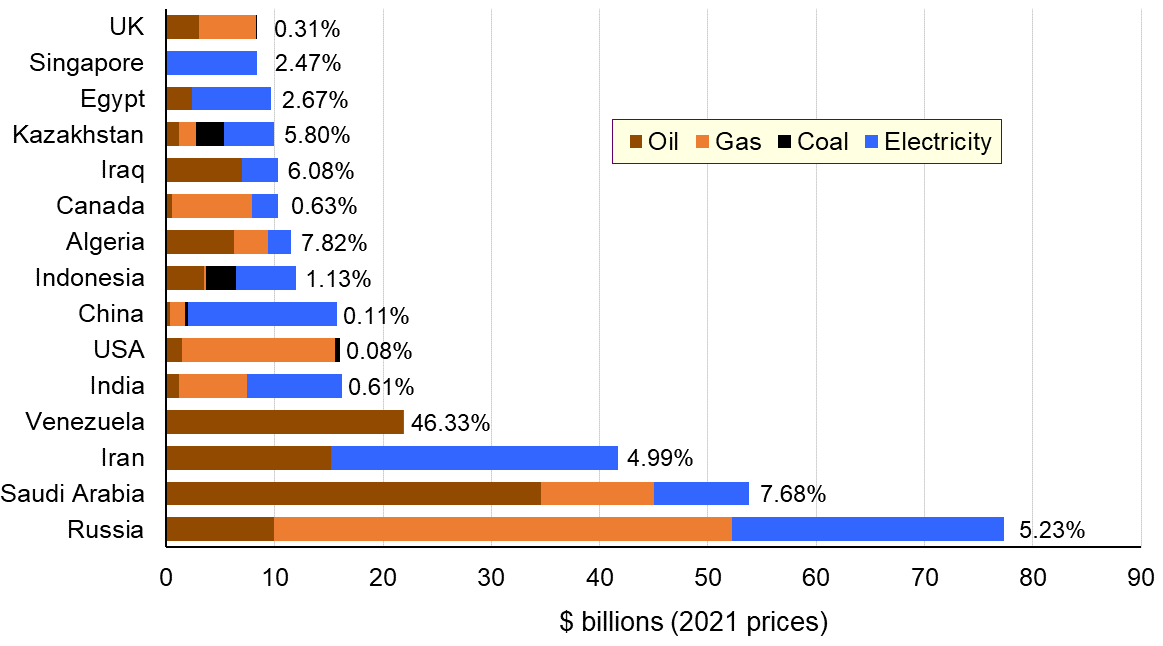 The chart shows the 15 countries providing the largest amount of support to fossil fuel industries in 2020 (in 2021 prices). The bars are in billions of dollars and the percentage of GDP is also given for each country. Subsidies include both production and consumption subsidies. (Click here for a PowerPoint of the chart.) In addition to the direct subsidies shown in the chart, there are the indirect costs of subsidies, including pollution, environmental destruction and the impact on the climate. According to the IMF, these amounted to $5.4 trillion in 2020.
The chart shows the 15 countries providing the largest amount of support to fossil fuel industries in 2020 (in 2021 prices). The bars are in billions of dollars and the percentage of GDP is also given for each country. Subsidies include both production and consumption subsidies. (Click here for a PowerPoint of the chart.) In addition to the direct subsidies shown in the chart, there are the indirect costs of subsidies, including pollution, environmental destruction and the impact on the climate. According to the IMF, these amounted to $5.4 trillion in 2020.
But getting countries to agree on a path to cutting subsidies, when conditions vary enormously from one country to another, proved very difficult.
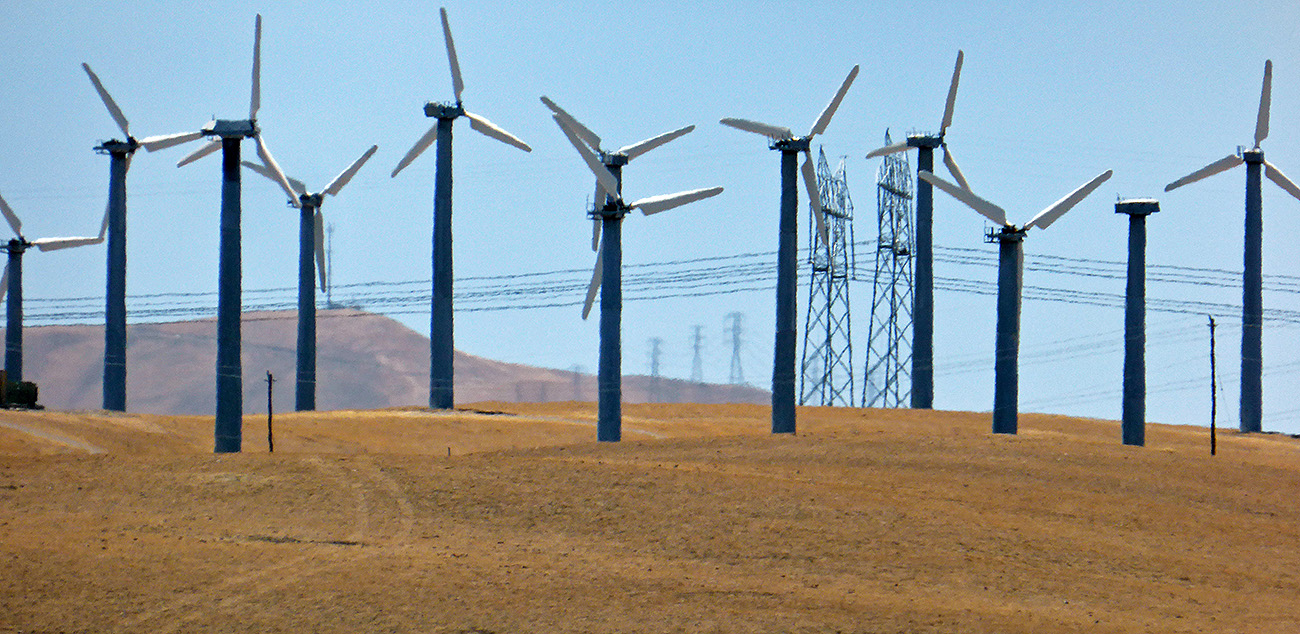 The first draft of the conference agreement called for countries to ‘to accelerate the phasing-out of coal and subsidies for fossil fuels’. But, after objections from major coal producing countries, such as China, India and Australia, this was weakened to calling on countries to accelerate the shift to clean energy systems ‘by scaling up the deployment of clean power generation and energy efficiency measures, including accelerating efforts towards the phasedown of unabated coal power and phase-out of inefficient fossil fuel subsidies’. (‘Unabated’ coal power refers to power generation with no carbon capture.) Changing ‘phasing-out’ to ‘the phasedown’ caused consternation among many delegates who saw this as a substantial weakening of the drive to end the use of coal.
The first draft of the conference agreement called for countries to ‘to accelerate the phasing-out of coal and subsidies for fossil fuels’. But, after objections from major coal producing countries, such as China, India and Australia, this was weakened to calling on countries to accelerate the shift to clean energy systems ‘by scaling up the deployment of clean power generation and energy efficiency measures, including accelerating efforts towards the phasedown of unabated coal power and phase-out of inefficient fossil fuel subsidies’. (‘Unabated’ coal power refers to power generation with no carbon capture.) Changing ‘phasing-out’ to ‘the phasedown’ caused consternation among many delegates who saw this as a substantial weakening of the drive to end the use of coal.
Another problem is in defining ‘inefficient’ subsidies. Countries are likely to define them in a way that suits them.
The key question was the extent to which countries would actually adopt such measures and what the details would be. Would they be strong enough? This remained to be seen.
As an article in the journal, Nature, points out:
There are three main barriers to removing production subsidies … First, fossil-fuel companies are powerful political groups. Second, there are legitimate concerns about job losses in communities that have few alternative employment options. And third, people often worry that rising energy prices might depress economic growth or trigger inflation.
The other question with the phasing out of subsidies is how and how much would there be ‘targeted support to the poorest and most vulnerable in line with national circumstances’.
Financial support for developing countries
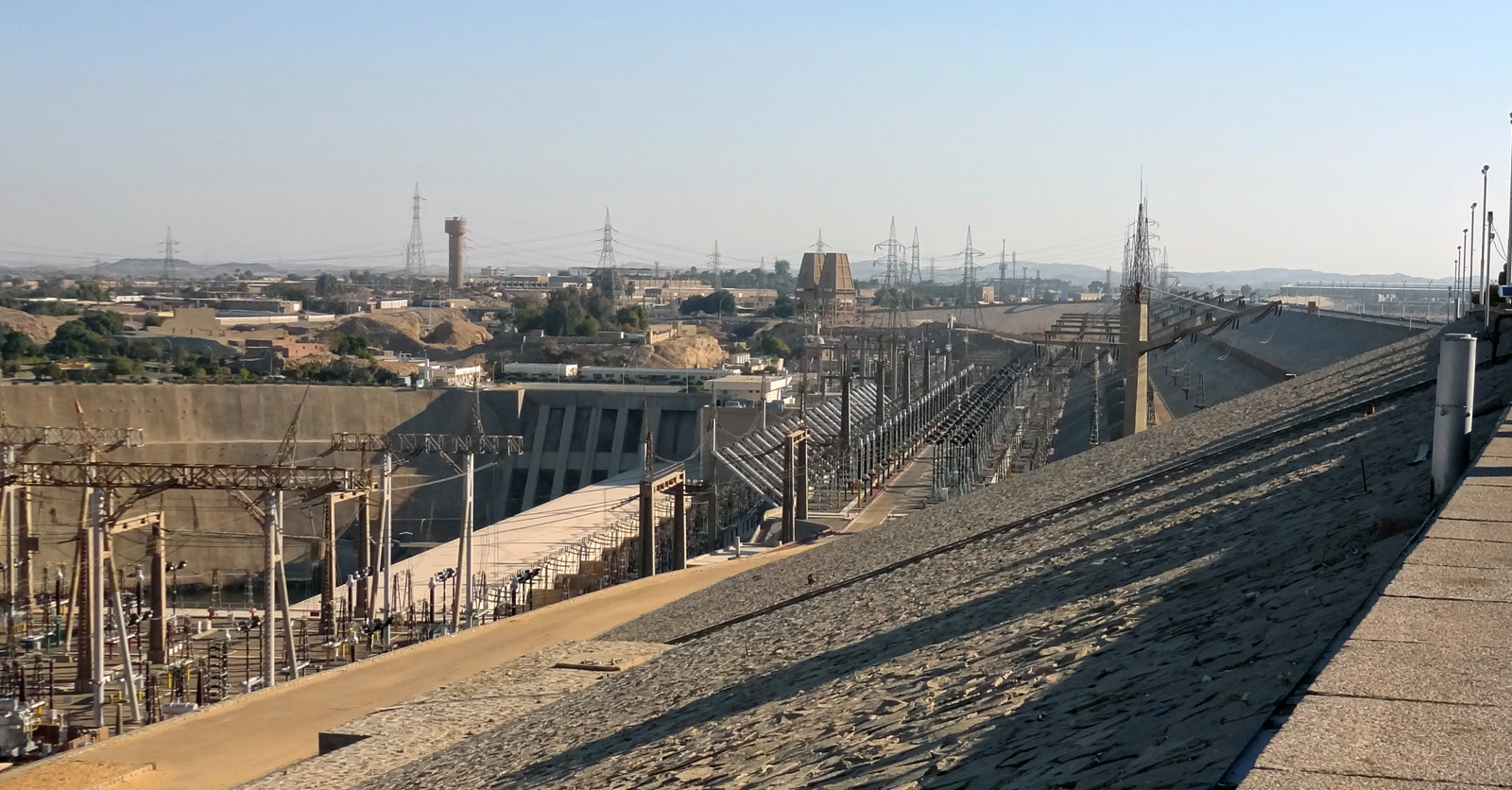 Transitioning to a low-carbon economy and investing in measures to protect people from rising sea levels, floods, droughts, fires, etc. costs money. With many developing countries facing serious financial problems, especially in the light of measures to support their economies and healthcare systems to mitigate the effects of COVID-19, support is needed from the developed world.
Transitioning to a low-carbon economy and investing in measures to protect people from rising sea levels, floods, droughts, fires, etc. costs money. With many developing countries facing serious financial problems, especially in the light of measures to support their economies and healthcare systems to mitigate the effects of COVID-19, support is needed from the developed world.
In the COP21 Paris Agreement in 2015, developed countries pledged $100 billion by 2020 to support mitigation of and adaptation to the effects of climate change by developing countries. But the target was not reached. The COP26 Pact urged ‘developed country Parties to fully deliver on the $100 billion goal urgently and through to 2025’. It also emphasised the importance of transparency in the implementation of their pledges. The proposal was also discussed to set up a trillion dollar per year fund from 2025, but no agreement was reached.
It remains to be seen just how much support will be given.
Then there was the question of compensating developing countries for the loss and damage which has already resulted from climate change. Large historical polluters, such as the USA, the UK and various EU countries, were unwilling to agree to a compensation mechanism, fearing that any recognition of culpability could make them open to lawsuits and demands for financial compensation.
Other decisions
- More than 100 countries at the meeting agreed to cut global methane emissions by at least 30 per cent from 2020 levels by 2030. Methane is a more powerful but shorter-living greenhouse gas than carbon. It is responsible for about a third of all human-generated global warming. China, India and Russia, however, did not sign up.
 Again, more than 100 countries agreed to stop deforestation by 2030. These countries include Indonesia and Brazil, which has been heavily criticised for allowing large parts of the Amazon rainforest to be cleared for farming, such that the Amazon region in recent years has been a net emitter of carbon from the felling and burning of trees. The pledge has been met with considerable cynicism, however, as it unclear how it will be policed. Much of the deforestation around the world is already illegal but goes ahead anyway.
Again, more than 100 countries agreed to stop deforestation by 2030. These countries include Indonesia and Brazil, which has been heavily criticised for allowing large parts of the Amazon rainforest to be cleared for farming, such that the Amazon region in recent years has been a net emitter of carbon from the felling and burning of trees. The pledge has been met with considerable cynicism, however, as it unclear how it will be policed. Much of the deforestation around the world is already illegal but goes ahead anyway.- A mechanism for trading carbon credits was agreed. This allows countries which plant forests or build wind farms to earn credits. However, it may simply provide a mechanism for rich countries and businesses to keep emitting as usual by buying credits.
- Forty-five countries pledged to invest in green agricultural practices to make farming more sustainable.
- Twenty-two countries signed a declaration to create zero-emission maritime shipping routes.
- The USA and China signed a joint declaration promising to boost co-operation over the next decade on various climate actions, including reducing methane emissions, tackling deforestation and regulating decarbonisation.
 Blah, blah, blah or real action?
Blah, blah, blah or real action?
Many of the decisions merely represent targets. What is essential is for countries clearly to spell out the mechanisms they will use for achieving them. So far there is too little detail. It was agreed, therefore, to reconvene in a year’s time at COP27 in Egypt. Countries will be expected to spell out in detail what actions they are taking to meet their emissions targets and other targets such as ending deforestation and reducing coal-fired generation.
Articles
- COP26 ended with the Glasgow Climate Pact. Here’s where it succeeded and failed
CNN, Angela Dewan and Amy Cassidy (14/11/21)
- Good COP, Bad COP: Separating heat from light at the climate summit
Ing, Samuel Abettan, Gerben Hieminga and Coco Zhang (15/11/21)
- COP26: What was agreed at the Glasgow climate conference?
BBC News (15/11/21)
- Five Things You Need to Know About The New Glasgow Climate Pact
The Conversation, Simon Lewis and Mark Maslin (13/11/21)
- Infographic: What has your country pledged at COP26?
Aljazeera, Hanna Duggal (14/11/21)
- Cop26: world on track for disastrous heating of more than 2.4C, says key report
The Guardian, Fiona Harvey (9/11/21)
- Cop26 took us one step closer to combating the climate crisis
The Guardian, Christiana Figueres (15/11/21)
- After the failure of Cop26, there’s only one last hope for our survival
The Guardian, George Monbiot (14/11/21)
- Why fossil fuel subsidies are so hard to kill
Nature, Jocelyn Timperley (20/10/21)
- The COP26 blah blah blah detector
Rappler, Elpidio Peria (16/11/21)
Podcasts
Videos
Report
Document
Questions
- What were the main achievements of COP26?
- What were the main failings of COP26?
- How can people be incentivised to reduce their direct and indirect greenhouse gas emissions?
- How is game theory relevant to understanding the difficulties in achieving global net zero emissions?
- Should developing countries be required to give up coal power?
- If the world is to achieve net zero greenhouse gas emissions, should all countries achieve net zero or should some countries achieve net negative emissions to allow others to continue with net positive emissions (albeit at a lower level)?
 Many economists argue that the most effective policy for dealing with climate change is carbon pricing. This reduces greenhouse gas (GHG) emissions in a way that minimises the costs to the economy.
Many economists argue that the most effective policy for dealing with climate change is carbon pricing. This reduces greenhouse gas (GHG) emissions in a way that minimises the costs to the economy.
For the policy to work effectively it is important that the price per tonne of CO2 equivalent (CO2e) does not vary with the activity that causes the emissions. In other words, whether you drive a car, heat your house using gas or travel by air, the GHGs you create need to be priced at a unified rate.
Governments can introduce carbon pricing in two different ways – cap-and-trade schemes and carbon taxes.
With a cap-and-trade policy, emission allowances are either issued or sold to the organisations covered by the scheme. They must accumulate enough of these allowances to match the actual level of emissions they produce or pay a large fine. After the initial allocation, allowances can be bought and sold in a secondary market and prices can be quite volatile.
With a carbon tax, the government directly sets the price of GHGs through the tax rate but has less control over the quantity of emissions.
Policy in the UK
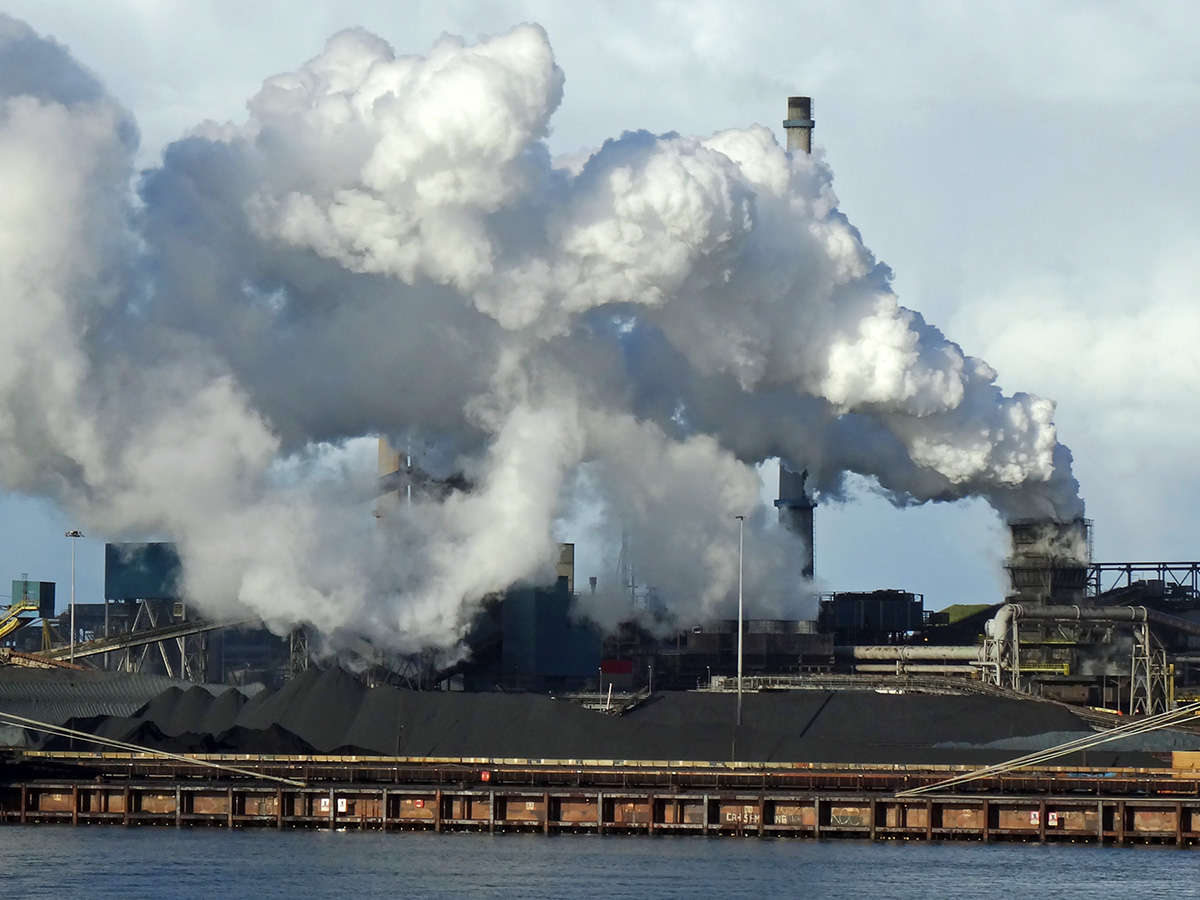 The UK Emissions Trading Scheme – an example of a cap-and-trade scheme – clearly places a price on GHG emissions. As this price is determined by market forces it can vary on a daily basis. The scheme applies to electricity generation and other energy-intensive industries that account for approximately 30 per cent of all emissions.
The UK Emissions Trading Scheme – an example of a cap-and-trade scheme – clearly places a price on GHG emissions. As this price is determined by market forces it can vary on a daily basis. The scheme applies to electricity generation and other energy-intensive industries that account for approximately 30 per cent of all emissions.
Although the UK does not have a specific carbon tax, it does have a number of different taxes that have an impact on the environment. Some of these have stated environmental objectives (e.g. the Climate Change Levy) while the main rationale for others is to raise revenue (fuel duty).
The tax rates are typically set on the output or consumption of the good rather than on emissions. For example, the Climate Change Levy applies to businesses’ use of electricity, gas and coal rather than the emissions the energy generates. Fuel duty depends on the amount of petrol consumed rather than the emissions the burning of that fuel generates. Clearly, emissions will tend to rise in proportion to the consumption/production of the good, but the relationship will not be precise.
The structure of VAT also influences emissions. The standard rate of VAT in the UK is 20 per cent. However, a lower level is applied to some goods/services that produce significant emissions. For example, the rate on household consumption of gas is 5 per cent while commercial passenger flights are zero rated. These lower tax rates are an implicit subsidy for the people who consume these goods/services. It makes them cheaper relative to the price of other goods.
Impact of the policies
Researchers from the Institute for Fiscal Studies have recently tried to analyse the impact of this complex range of policies on the price of carbon. The results indicate wide variations depending on the activity that causes the emissions.
One of the most significant differences is between gas and electricity. For example, non-energy-intensive businesses pay a price of £229.10 per tonne of CO2e from electricity generation but only £30.50 per tonne from burning gas. The response to the incentives this creates is unsurprising. One of the biggest contributing factors to the fall in territorial emissions in the UK has come from the decarbonisation of electricity supply: i.e. the switch away from coal-fired generation.
 The impact of government policy on UK households creates quite perverse incentives. Because of the lower rates of VAT, families receive an implicit subsidy of £24 per tonne CO2e when they use gas to heat their homes. When they use electricity, the source of energy that generates less emissions, they face a positive price of £137 per tonne of CO2e. Once again, the response to these incentives is unsurprising. Household emissions only fell by a relatively small amount between 1990 and 2018 because of the continued use of gas for heating and cooking.
The impact of government policy on UK households creates quite perverse incentives. Because of the lower rates of VAT, families receive an implicit subsidy of £24 per tonne CO2e when they use gas to heat their homes. When they use electricity, the source of energy that generates less emissions, they face a positive price of £137 per tonne of CO2e. Once again, the response to these incentives is unsurprising. Household emissions only fell by a relatively small amount between 1990 and 2018 because of the continued use of gas for heating and cooking.
Unsurprisingly many commentators have referred to carbon pricing in the UK as a confusing mess and have called for a unified rate across all activities to minimise the costs to the economy. Another important issue is the level at which a new unified rate is set. Some research by the Department for Business, Energy and Industrial Strategy suggests that the figure would have to be set between £122 and £36 per tonne of CO2e in order for the UK to reach its target of net zero emissions by 2050.
A higher unified rate would also create another problem – the distributional impact. Poorer households spend a much greater share of their income on electricity, heating and food and so would be disproportionately affected by the policy. For the policy to be politically acceptable, the government will need to find an effective way to compensate these groups.
Articles
Report
Questions
- Outline the difference between territorial and consumption emissions.
- Using the concepts of rivalry and excludability, explain why GHGs and the climate change they cause are an example of market failure.
- Discuss the main differences between cap-and trade schemes and carbon emission taxes.
- Explain why a unified carbon price would minimise the costs to the economy of reducing the level of GHG emissions.
- Discuss some of the potential limitations of introducing carbon pricing and explain why some countries are considering the implementation of a Carbon Border Adjustment mechanism.
 The development of open-source software and blockchain technology has enabled people to ‘hack’ capitalism – to present and provide alternatives to traditional modes of production, consumption and exchange. This has enabled more effective markets in second-hand products, new environmentally-friendly technologies and by-products that otherwise would have been negative externalities. Cryptocurrencies are increasingly providing the medium of exchange in such markets.
The development of open-source software and blockchain technology has enabled people to ‘hack’ capitalism – to present and provide alternatives to traditional modes of production, consumption and exchange. This has enabled more effective markets in second-hand products, new environmentally-friendly technologies and by-products that otherwise would have been negative externalities. Cryptocurrencies are increasingly providing the medium of exchange in such markets.
In a BBC podcast, Hacking Capitalism, Leo Johnson, head of PwC’s Disruption Practice and younger brother of Boris Johnson, argues that various changes to the way capitalism operates can make it much more effective in improving the lives of everyone, including those left behind in the current world. The changes can help address the failings of capitalism, such as climate change, environmental destruction, poverty and inequality, corruption, a reinforcement of economic and political power and the lack of general access to capital. And these changes are already taking place around the world and could lead to a new ‘golden age’ for capitalism.
 The changes are built on new attitudes and new technologies. New attitudes include regarding nature and the land as living resources that need respect. This would involve moving away from monocultures and deforestation and, with appropriate technologies (old and new), could lead to greater output, greater equality within agriculture and increased carbon absorption. The podcast gives examples from the developing and developed world of successful moves towards smaller-scale and more diversified agriculture that are much more sustainable. The rise in farmers’ markets provides an important mechanism to drive both demand and supply.
The changes are built on new attitudes and new technologies. New attitudes include regarding nature and the land as living resources that need respect. This would involve moving away from monocultures and deforestation and, with appropriate technologies (old and new), could lead to greater output, greater equality within agriculture and increased carbon absorption. The podcast gives examples from the developing and developed world of successful moves towards smaller-scale and more diversified agriculture that are much more sustainable. The rise in farmers’ markets provides an important mechanism to drive both demand and supply.
In the current model of capitalism there are many barriers to prevent the poor from benefiting from the system. As the podcast states, there are some 2 billion people across the world with no access to finance, 2.6 billion without access to sanitation, 1.2 billion without access to power – a set of barriers that stops capitalism from unlocking the skills and productivity of the many.
 These problems were made worse by the response to the financial crisis of 2007–8, when governments chose to save the existing model of capitalism by propping up financial markets through quantitative easing, which massively inflated asset prices and aggravated the problem of inequality. They missed the opportunity of creating money to invest in alternative technologies and infrastructure.
These problems were made worse by the response to the financial crisis of 2007–8, when governments chose to save the existing model of capitalism by propping up financial markets through quantitative easing, which massively inflated asset prices and aggravated the problem of inequality. They missed the opportunity of creating money to invest in alternative technologies and infrastructure.
New technology is the key to developing this new fairer, more sustainable model of capitalism. Such technologies could be developed (and are being in many cases) by co-operative, open-source methods. Many people, through these methods, could contribute to the development of products and their adaptation to meet different needs. The barriers of intellectual property rights are by-passed.
New technologies that allow easy rental or sharing of equipment (such as tractors) by poor farmers can transform lives and massively increase productivity. So too can the development of cryptocurrencies to allow access to finance for small farmers and businesses. This is particularly important in countries where access to traditional finance is restricted and/or where the currency is not stable with high inflation rates.
Blockchain technology can also help to drive second-hand markets by providing greater transparency and thereby cut waste. Manufacturers could take a stake in such markets through a process of certification or transfer.
 A final hack is one that can directly tackle the problem of externalities – one of the greatest weaknesses of conventional capitalism. New technologies can support ways of rewarding people for reducing external costs, such as paying indigenous people for protecting the land or forests. Carbon markets have been developed in recent years. Perhaps the best example is the European Emissions Trading Scheme (EMS). But so far they have been developed in isolation. If the revenues generated could go directly to those involved in environmental protection, this would help further to internalise the externalities. The podcasts gives an example of a technology used in the Amazon to identify the environmental benefits of protecting rain forests that can then be used to allow reliable payments to the indigenous people though blockchain currencies.
A final hack is one that can directly tackle the problem of externalities – one of the greatest weaknesses of conventional capitalism. New technologies can support ways of rewarding people for reducing external costs, such as paying indigenous people for protecting the land or forests. Carbon markets have been developed in recent years. Perhaps the best example is the European Emissions Trading Scheme (EMS). But so far they have been developed in isolation. If the revenues generated could go directly to those involved in environmental protection, this would help further to internalise the externalities. The podcasts gives an example of a technology used in the Amazon to identify the environmental benefits of protecting rain forests that can then be used to allow reliable payments to the indigenous people though blockchain currencies.
Podcast
Questions
- What are the main reasons why capitalism has led to such great inequality?
- What do you understand by ‘hacking’ capitalism?
- How is open-source software relevant to the development of technology that can have broad benefits across society?
- Does the current model of capitalism encourage a self-centred approach to life?
- How might blockchain technology help in the development of a more inclusive and fairer form of capitalism?
- How might farmers’ co-operatives encourage rural development?
- What are the political obstacles to the developments considered in the podcast?

The transition towards clean energy in combination with a shortfall in supply has seen the price of raw uranium, also known as ‘yellowcake’, rise almost 60 per cent in recent weeks. It is now trading at over $50 a pound – a nine-year high. The market has been described as being at a ‘tipping point’. Given the recent boom in the market, the current conditions could tip the balance towards an era of rising uranium prices.
What is uranium?
Uranium is a heavy metal which has been used as a source of concentrated energy for over 60 years. Uranium ore can be mined from underground, milled, and then sold. It is then used in a nuclear reactor for electricity generation. About 10% of the world’s electricity is generated from uranium in nuclear reactors. There are some 445 nuclear reactors operating in 32 countries. It is the most energy-dense and efficient fuel source we have, with just ten uranium pellets able to power the average household for an entire year.
In March 2011, Japan’s most powerful earthquake on record triggered a tsunami, which then caused a meltdown at a nuclear power plant in Fukushima. It forced residents from their homes as radiation leaked from the plant. Since the Fukushima accident, uranium prices had been on a downtrend trend – enough to force several miners to suspend or scale back operations.
However, there has been a 42 per cent increase in the price of the metal in the first nine months of 2021 alone.
Demand for uranium
Since launching in July, a new investment trust, run by Canadian asset manager Sprott, has snapped up about 6m pounds of physical uranium, worth about $240m. This aggressive buying has helped push prices of uranium to more than $40 per pound, up from $30 at the start of the year. In the first part of September alone, prices surged by around 40%, outperforming all other major commodities. In just a few weeks, millions of pounds of supply were scooped up by the Sprott Physical Uranium Trust. This puts pressure on utilities that need to secure supplies of the commodity for electricity generation.
This increased demand is occurring at precisely the same time as countries and companies around the world are committing to net-zero carbon targets. As a result, nuclear power companies are now facing competition for supplies of uranium from financial investors, who are betting on sharply higher prices and demand for the radioactive material used to fuel reactors. This boost in demand is said to be due to uranium being used as a low-carbon energy source, despite the radioactive waste problem that comes with it. Investors are betting that nuclear power will be a key part of the move away from fossil fuels.
Production from world uranium mines has in recent years supplied 90% of the requirements of power utilities for uranium, with the current global mine supply expected to be about 125m pounds for 2021. In addition, there are secondary sources such as commercial and military stockpiles. However, according to the World Nuclear Association, demand for uranium is expected to climb from about 162m pounds this year to 206m pounds in 2030, and to 292m pounds by 2040. This is largely driven by increased power generation in China. China is planning a big increase in its nuclear power capacity over the next decade as the country seeks to cut its emissions.
Supply of uranium
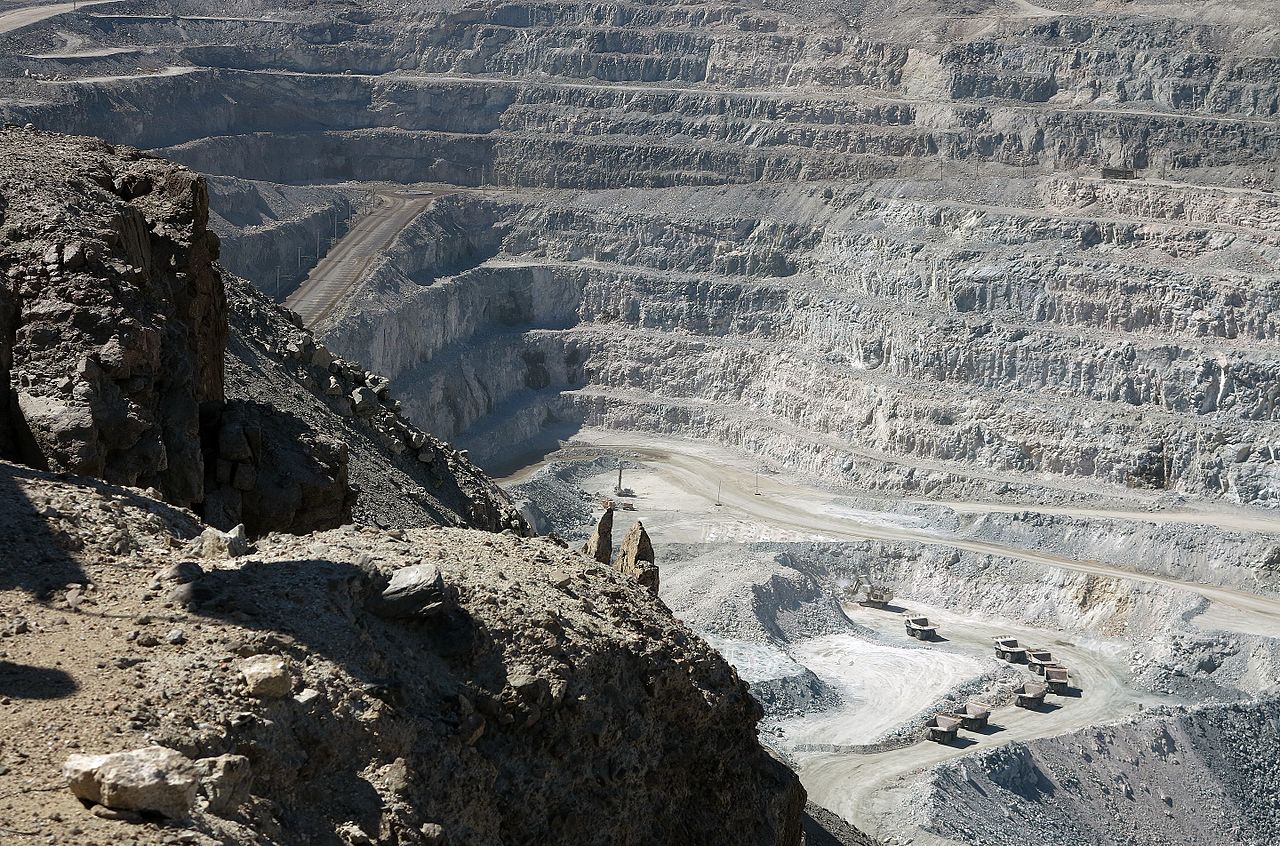 Although uranium is relatively abundant in the Earth’s crust, not all uranium deposits are economically recoverable. While some countries have uranium resources that can be mined profitably when prices are low, others do not. Kazakhstan is the largest producer of uranium and in 2019 produced more uranium than the second, third, and fourth-largest producers combined.
Although uranium is relatively abundant in the Earth’s crust, not all uranium deposits are economically recoverable. While some countries have uranium resources that can be mined profitably when prices are low, others do not. Kazakhstan is the largest producer of uranium and in 2019 produced more uranium than the second, third, and fourth-largest producers combined.
The big issue is that supply to the market is falling significantly. For deliveries that would start in 2022, Kazakh producer, Kazatomprom, is now discussing the possibility of supplying the metal directly to Sprott. However, it also warned of the risk that its mines would not reach their output target for 2021, and it said earlier this year that it would keep its production at reduced levels through 2023. In addition to this, the recent surge in buying is also reducing the inventories that accumulated after the Fukushima accident.
The supply of uranium is set to fall 15 per cent by 2025 and by 50 per cent by 2030. This is mainly due to a lack of investment in new mines. The lack of new uranium mines will mean the price has to move higher. Namibian mines, accounting for 8 per cent of world supply, are approaching the end of their lives. Cameco of Canada, another important source, has shut one large pit because of uneconomic prices. According to BMO Capital, a mine supply deficit since 2019 will continue.
Supply has also been affected by the pandemic. The boom in demand has coincided with historically low prices and pandemic-driven mine disruptions, prompting uranium producers to buy from the spot market to fulfil long-term contracts with consumers. Some of the largest mining operations in Canada and Kazakhstan had to suspend production temporarily due to a shortage of workers.
Adding to the security of supply concerns is the role of commercial and state-owned entities in the uranium market. Uranium is a highly trade-dependent commodity with international trade policies highlighting the disconnect between where uranium is produced and where it is consumed. About 80% of primary production comes from countries that consume little-to-no uranium, and nearly 90% of uranium consumption occurs in countries that have little-to-no primary production. As a result, government-driven trade policies can be particularly disruptive for the uranium market. It is argued that the risk to uranium supply may create a renewed focus on ensuring availability of long-term supply to fuel nuclear reactors.
The role of financial players
Financial players have been accelerating the recent recovery in the price of uranium, with large-scale speculative buying and withholding of supply. But it can be argued that this would not have occurred if there were not a fundamental and substantial shortage.
 If investors keep buying uranium, analysts expect utility companies will come under pressure to replace long-term supply agreements before they expire. At the moment, long-term contracts cover 98 per cent of the uranium needed by US utility companies. But that figure drops to 84 per cent next year, and 55 per cent by 2025, according to uranium investment company, Yellow Cake.
If investors keep buying uranium, analysts expect utility companies will come under pressure to replace long-term supply agreements before they expire. At the moment, long-term contracts cover 98 per cent of the uranium needed by US utility companies. But that figure drops to 84 per cent next year, and 55 per cent by 2025, according to uranium investment company, Yellow Cake.
As annual supply declines, demand for uranium from producers and financial players increases, and with trade policy potentially restricting access to some markets, it is believed the pounds available in the spot market will not be adequate to satisfy the growing backlog of long-term demand. As a result, companies expect there will be increased competition to secure uranium under long-term contracts on terms that will ensure the availability of reliable primary supply to meet growing demand.
What will the future look like?
Many countries are turning their attention to nuclear power in order to become net-zero economies. Even in Japan, nuclear generation has slowly been returning. It is argued that nuclear power is needed to some degree for the country to achieve its pollution-curbing goals. However, not all nations are re-embracing nuclear. Germany, for example, is set to shut its last reactor next year.
The concern is whether the recent gains in investor demand is enough to underpin the market. It can be argued that even before the recent price rally started, demand for uranium from the investment sector was already growing. However, observers of the market have suggested that just as quickly as uranium skyrocketed, prices may now be hitting the brakes. Producer stocks that got swept up in the frenzy seem to have peaked. In addition, the world’s top uranium miner Kazatomprom has warned that the recent price action was being fuelled by financial investors rather than the utilities that use the radioactive metal as fuel in their reactors. On the other hand, it is argued that this pickup in the spot market will be the catalyst to push more utilities to get involved in term contracting.
Despite the impact of the pandemic on global energy demand, it is now growing again. Gas and other energy shortages are being seen and the price of gas has been rising rapidly. This rise in energy prices plus a focus on carbon-free generation is likely to continue driving demand for nuclear power and hence for uranium. In addition, producers have warned of supply shortages in the long term as investors scoop up physical inventory and new mines are not starting quickly enough. Thus nuclear’s growing role in the clean energy transition, in addition to a supply shortfall, could turn the tide for the uranium industry.
Articles
Data
Questions
- Using the uranium market as an example, describe the relationship between an increase in demand and the market price.
- Explain whether the supply of uranium would be price elastic or inelastic in (a) the short run; (b) the long run.
- What is the role of speculation in determining the recent movements in the price of uranium and likely future price movements?
- Given your answers to the above questions, draw supply and demand diagrams to illustrate (a) the recent increase in the market price of uranium; (b) the likely price of uranium in five years from now.
 Competition authorities across the globe have recently been paying close attention to the activity of large firms in high-tech markets, in particular Google, Amazon, Facebook and Apple. One estimate suggests that 30 cases have been opened by the authorities since 2010, and a third of these were launched in 2020.
Competition authorities across the globe have recently been paying close attention to the activity of large firms in high-tech markets, in particular Google, Amazon, Facebook and Apple. One estimate suggests that 30 cases have been opened by the authorities since 2010, and a third of these were launched in 2020.
One of the most prominent recent cases in the US courts concerns a complaint made by Epic Games, producer of the popular Fortnite game, against Apple. The background to the case is Apple’s standard practice on its App Store of taking a 30% cut of all paid app and in-app purchases. Therefore, a Fortnite player purchasing $10 worth of in-game currency would result in $7 for Epic and $3 for Apple.
However, in August 2020 Epic decided, contrary to Apple’s terms and conditions, to offer players an alternative way to purchase in-game currency. Gamers would see a choice screen giving them the option to buy currency through the Apple App Store or to buy it directly from Epic. Crucially, purchasing directly from Epic would be cheaper. For example, the same $10 worth of in-game currency on the App Store would cost only $8 if purchased directly from Epic.
It is clear to see why Epic was in favour of direct payments – it earns revenue of $8 instead of $7. However, note that the benefits for gamers are even larger – they save $2 by buying directly. In other words, Epic is passing on 2/3 of the cost saving to consumers.
Apple very quickly responded to Epic’s introduction of the direct purchase alternative by removing Fortnite from the App Store. Epic then filed a complaint with the US District Court.
The Epic v Apple court case
The case concerned Apple restricting game developers’ ability to promote purchasing mechanisms outside the App Store. However, more broadly, it also examined Apple’s complete control of the iOS app market since all apps must be distributed through the Apple App Store. Epic had previously disrupted PC games distribution by launching its own platform with lower fees. The setup of iOS and Apple’s actions against Epic make this an impossible way to reach users.
 The Court’s analysis of the Epic v Apple case depended upon several key factors. First, the market definition. To be found to have breached competition law Apple must have a significant share of the market. If the market is defined as that for iOS apps, this is clearly the case. However, if, as Apple argues, it is broader, encompassing the options to play Epic games through web browsers, gaming consoles and PCs, then this is not the case.
The Court’s analysis of the Epic v Apple case depended upon several key factors. First, the market definition. To be found to have breached competition law Apple must have a significant share of the market. If the market is defined as that for iOS apps, this is clearly the case. However, if, as Apple argues, it is broader, encompassing the options to play Epic games through web browsers, gaming consoles and PCs, then this is not the case.
Second, even if the market is narrowly defined, Apple argues that its control of the app distribution market is essential to provide user friendly and secure provision of apps. Furthermore, revenue extracted from app producers can enable more investment in the iOS. Without Apple controlling the market, app producers would be able to free-ride on the visibility the App Store provides for their apps.
The ruling
The US Court announced its ruling on 10 September 2021. The judge decided that the market was broader than just iOS and thus Apple is not considered to be a monopolist. This has been touted as a major success for Apple, as it will allow the company to maintain its control of the app distribution market. However, the Court also ruled that Apple must allow game developers to link and direct users to alternative purchasing methods outside the App Store.
The Court’s decision in the Epic v Apple case closely follows concessions recently made by Apple for so called ‘reader apps’ such as Spotify and Netflix. Following an investigation by the Japanese authorities, these concessions allowed such apps to promote and receive purchases directly from consumers as long as they were made outside the app. These apps could be treated differently, as digital goods are consumed on multiple devices. However, the decision in the Epic case now extends such concessions to gaming apps.
It is unclear whether Apple will appeal the decision in the case Epic brought. If not, Apple stands to lose considerable revenue from its 30% share of in-app purchases. It will be very interesting to see how this ruling affects how Apple runs the App Store. Epic, on the other hand, has already made clear it will appeal the decision, aiming to prevent Apple gaining a share of any payment users make outside the app.
Matt Olczak and Jon Guest
Articles
Questions
- Why might a firm involved in a competition case, such as Apple, try to convince the authorities to define the relevant market as broadly as possible?
- Using the example of the Epic v Apple case, explain how Apple’s actions could be seen as both exclusionary and exploitative abuses of a dominant position.

 Governments can incentivise individuals and firms through emissions and product taxes, through carbon pricing, through cap-and-trade schemes, through subsidies on green investment, production and consumption, through legal limits on emissions, through trying to change behaviour by education campaigns, and so on. In each case, the extent to which individuals and firms will respond is hard to predict. People may want to reduce global warming and yet be reluctant to change their own behaviour, seeing themselves as too insignificant to make any difference and blaming big business, governments or rich individuals. It is important, therefore, for governments to get incentive mechanisms right to achieve the stated targets.
Governments can incentivise individuals and firms through emissions and product taxes, through carbon pricing, through cap-and-trade schemes, through subsidies on green investment, production and consumption, through legal limits on emissions, through trying to change behaviour by education campaigns, and so on. In each case, the extent to which individuals and firms will respond is hard to predict. People may want to reduce global warming and yet be reluctant to change their own behaviour, seeing themselves as too insignificant to make any difference and blaming big business, governments or rich individuals. It is important, therefore, for governments to get incentive mechanisms right to achieve the stated targets. The chart shows the 15 countries providing the largest amount of support to fossil fuel industries in 2020 (in 2021 prices). The bars are in billions of dollars and the percentage of GDP is also given for each country. Subsidies include both production and consumption subsidies. (Click here for a PowerPoint of the chart.) In addition to the direct subsidies shown in the chart, there are the indirect costs of subsidies, including pollution, environmental destruction and the impact on the climate. According to the IMF, these amounted to $5.4 trillion in 2020.
The chart shows the 15 countries providing the largest amount of support to fossil fuel industries in 2020 (in 2021 prices). The bars are in billions of dollars and the percentage of GDP is also given for each country. Subsidies include both production and consumption subsidies. (Click here for a PowerPoint of the chart.) In addition to the direct subsidies shown in the chart, there are the indirect costs of subsidies, including pollution, environmental destruction and the impact on the climate. According to the IMF, these amounted to $5.4 trillion in 2020. The first draft of the conference agreement called for countries to ‘to accelerate the phasing-out of coal and subsidies for fossil fuels’. But, after objections from major coal producing countries, such as China, India and Australia, this was weakened to calling on countries to accelerate the shift to clean energy systems ‘by scaling up the deployment of clean power generation and energy efficiency measures, including accelerating efforts towards the phasedown of unabated coal power and phase-out of inefficient fossil fuel subsidies’. (‘Unabated’ coal power refers to power generation with no carbon capture.) Changing ‘phasing-out’ to ‘the phasedown’ caused consternation among many delegates who saw this as a substantial weakening of the drive to end the use of coal.
The first draft of the conference agreement called for countries to ‘to accelerate the phasing-out of coal and subsidies for fossil fuels’. But, after objections from major coal producing countries, such as China, India and Australia, this was weakened to calling on countries to accelerate the shift to clean energy systems ‘by scaling up the deployment of clean power generation and energy efficiency measures, including accelerating efforts towards the phasedown of unabated coal power and phase-out of inefficient fossil fuel subsidies’. (‘Unabated’ coal power refers to power generation with no carbon capture.) Changing ‘phasing-out’ to ‘the phasedown’ caused consternation among many delegates who saw this as a substantial weakening of the drive to end the use of coal.  Transitioning to a low-carbon economy and investing in measures to protect people from rising sea levels, floods, droughts, fires, etc. costs money. With many developing countries facing serious financial problems, especially in the light of measures to support their economies and healthcare systems to mitigate the effects of COVID-19, support is needed from the developed world.
Transitioning to a low-carbon economy and investing in measures to protect people from rising sea levels, floods, droughts, fires, etc. costs money. With many developing countries facing serious financial problems, especially in the light of measures to support their economies and healthcare systems to mitigate the effects of COVID-19, support is needed from the developed world. Again, more than 100 countries agreed to stop deforestation by 2030. These countries include Indonesia and Brazil, which has been heavily criticised for allowing large parts of the Amazon rainforest to be cleared for farming, such that the Amazon region in recent years has been a net emitter of carbon from the felling and burning of trees. The pledge has been met with considerable cynicism, however, as it unclear how it will be policed. Much of the deforestation around the world is already illegal but goes ahead anyway.
Again, more than 100 countries agreed to stop deforestation by 2030. These countries include Indonesia and Brazil, which has been heavily criticised for allowing large parts of the Amazon rainforest to be cleared for farming, such that the Amazon region in recent years has been a net emitter of carbon from the felling and burning of trees. The pledge has been met with considerable cynicism, however, as it unclear how it will be policed. Much of the deforestation around the world is already illegal but goes ahead anyway. Blah, blah, blah or real action?
Blah, blah, blah or real action? What’s in the COP26 deal – and will it save humanity?
What’s in the COP26 deal – and will it save humanity? Cop26: where does the world go from here?
Cop26: where does the world go from here? What is net zero?
What is net zero? Ros Atkins On: The Challenge of Net Zero
Ros Atkins On: The Challenge of Net Zero What is carbon trading?
What is carbon trading? Many economists argue that the most effective policy for dealing with climate change is carbon pricing. This reduces greenhouse gas (GHG) emissions in a way that minimises the costs to the economy.
Many economists argue that the most effective policy for dealing with climate change is carbon pricing. This reduces greenhouse gas (GHG) emissions in a way that minimises the costs to the economy. The UK Emissions Trading Scheme – an example of a cap-and-trade scheme – clearly places a price on GHG emissions. As this price is determined by market forces it can vary on a daily basis. The scheme applies to electricity generation and other energy-intensive industries that account for approximately 30 per cent of all emissions.
The UK Emissions Trading Scheme – an example of a cap-and-trade scheme – clearly places a price on GHG emissions. As this price is determined by market forces it can vary on a daily basis. The scheme applies to electricity generation and other energy-intensive industries that account for approximately 30 per cent of all emissions. The impact of government policy on UK households creates quite perverse incentives. Because of the lower rates of VAT, families receive an implicit subsidy of £24 per tonne CO2e when they use gas to heat their homes. When they use electricity, the source of energy that generates less emissions, they face a positive price of £137 per tonne of CO2e. Once again, the response to these incentives is unsurprising. Household emissions only fell by a relatively small amount between 1990 and 2018 because of the continued use of gas for heating and cooking.
The impact of government policy on UK households creates quite perverse incentives. Because of the lower rates of VAT, families receive an implicit subsidy of £24 per tonne CO2e when they use gas to heat their homes. When they use electricity, the source of energy that generates less emissions, they face a positive price of £137 per tonne of CO2e. Once again, the response to these incentives is unsurprising. Household emissions only fell by a relatively small amount between 1990 and 2018 because of the continued use of gas for heating and cooking. The development of open-source software and blockchain technology has enabled people to ‘hack’ capitalism – to present and provide alternatives to traditional modes of production, consumption and exchange. This has enabled more effective markets in second-hand products, new environmentally-friendly technologies and by-products that otherwise would have been negative externalities.
The development of open-source software and blockchain technology has enabled people to ‘hack’ capitalism – to present and provide alternatives to traditional modes of production, consumption and exchange. This has enabled more effective markets in second-hand products, new environmentally-friendly technologies and by-products that otherwise would have been negative externalities.  The changes are built on new attitudes and new technologies. New attitudes include regarding nature and the land as living resources that need respect. This would involve moving away from monocultures and deforestation and, with appropriate technologies (old and new), could lead to greater output, greater equality within agriculture and increased carbon absorption. The podcast gives examples from the developing and developed world of successful moves towards smaller-scale and more diversified agriculture that are much more sustainable. The rise in farmers’ markets provides an important mechanism to drive both demand and supply.
The changes are built on new attitudes and new technologies. New attitudes include regarding nature and the land as living resources that need respect. This would involve moving away from monocultures and deforestation and, with appropriate technologies (old and new), could lead to greater output, greater equality within agriculture and increased carbon absorption. The podcast gives examples from the developing and developed world of successful moves towards smaller-scale and more diversified agriculture that are much more sustainable. The rise in farmers’ markets provides an important mechanism to drive both demand and supply. These problems were made worse by the response to the financial crisis of 2007–8, when governments chose to save the existing model of capitalism by propping up financial markets through quantitative easing, which massively inflated asset prices and aggravated the problem of inequality. They missed the opportunity of creating money to invest in alternative technologies and infrastructure.
These problems were made worse by the response to the financial crisis of 2007–8, when governments chose to save the existing model of capitalism by propping up financial markets through quantitative easing, which massively inflated asset prices and aggravated the problem of inequality. They missed the opportunity of creating money to invest in alternative technologies and infrastructure. A final hack is one that can directly tackle the problem of externalities – one of the greatest weaknesses of conventional capitalism. New technologies can support ways of rewarding people for reducing external costs, such as paying indigenous people for protecting the land or forests. Carbon markets have been developed in recent years. Perhaps the best example is the European Emissions Trading Scheme (EMS). But so far they have been developed in isolation. If the revenues generated could go directly to those involved in environmental protection, this would help further to internalise the externalities. The podcasts gives an example of a technology used in the Amazon to identify the environmental benefits of protecting rain forests that can then be used to allow reliable payments to the indigenous people though blockchain currencies.
A final hack is one that can directly tackle the problem of externalities – one of the greatest weaknesses of conventional capitalism. New technologies can support ways of rewarding people for reducing external costs, such as paying indigenous people for protecting the land or forests. Carbon markets have been developed in recent years. Perhaps the best example is the European Emissions Trading Scheme (EMS). But so far they have been developed in isolation. If the revenues generated could go directly to those involved in environmental protection, this would help further to internalise the externalities. The podcasts gives an example of a technology used in the Amazon to identify the environmental benefits of protecting rain forests that can then be used to allow reliable payments to the indigenous people though blockchain currencies.
 Although uranium is relatively abundant in the Earth’s crust, not all uranium deposits are economically recoverable. While some countries have uranium resources that can be mined profitably when prices are low, others do not. Kazakhstan is the largest producer of uranium and in 2019 produced more uranium than the second, third, and fourth-largest producers combined.
Although uranium is relatively abundant in the Earth’s crust, not all uranium deposits are economically recoverable. While some countries have uranium resources that can be mined profitably when prices are low, others do not. Kazakhstan is the largest producer of uranium and in 2019 produced more uranium than the second, third, and fourth-largest producers combined. If investors keep buying uranium, analysts expect utility companies will come under pressure to replace long-term supply agreements before they expire. At the moment, long-term contracts cover 98 per cent of the uranium needed by US utility companies. But that figure drops to 84 per cent next year, and 55 per cent by 2025, according to uranium investment company, Yellow Cake.
If investors keep buying uranium, analysts expect utility companies will come under pressure to replace long-term supply agreements before they expire. At the moment, long-term contracts cover 98 per cent of the uranium needed by US utility companies. But that figure drops to 84 per cent next year, and 55 per cent by 2025, according to uranium investment company, Yellow Cake.  Competition authorities across the globe have recently been paying close attention to the activity of large firms in high-tech markets, in particular Google, Amazon, Facebook and Apple. One estimate suggests that 30 cases have been opened by the authorities since 2010, and a third of these were launched in 2020.
Competition authorities across the globe have recently been paying close attention to the activity of large firms in high-tech markets, in particular Google, Amazon, Facebook and Apple. One estimate suggests that 30 cases have been opened by the authorities since 2010, and a third of these were launched in 2020.  The Court’s analysis of the Epic v Apple case depended upon several key factors. First, the market definition. To be found to have breached competition law Apple must have a significant share of the market. If the market is defined as that for iOS apps, this is clearly the case. However, if, as Apple argues, it is broader, encompassing the options to play Epic games through web browsers, gaming consoles and PCs, then this is not the case.
The Court’s analysis of the Epic v Apple case depended upon several key factors. First, the market definition. To be found to have breached competition law Apple must have a significant share of the market. If the market is defined as that for iOS apps, this is clearly the case. However, if, as Apple argues, it is broader, encompassing the options to play Epic games through web browsers, gaming consoles and PCs, then this is not the case.